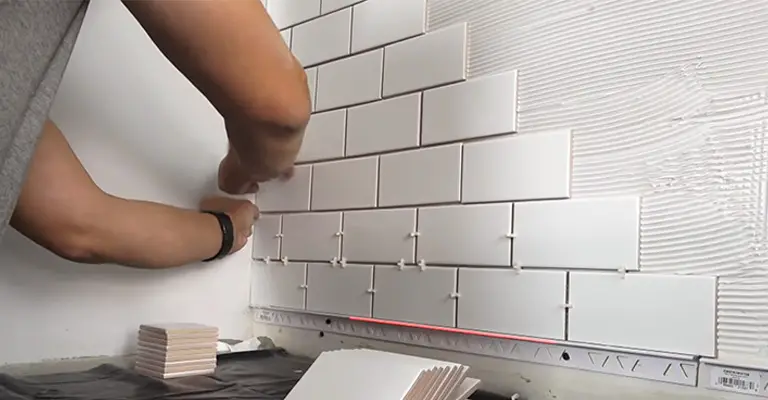Tired of the outdated look of your laminate backsplash and eager to give your kitchen a fresh, modern update? Tiling over a laminate backsplash might be the perfect solution for you!
Whether you’re a seasoned DIY enthusiast or a novice looking to take on a new home improvement project, this guide will walk you through the steps to transform your kitchen’s appearance without the need for extensive demolition or costly renovations.
Laminate Backsplash – Can I Tile Over It?
It is possible to tile over laminate if it is well-attached. It’s probably best to use mastic instead of thinset, though.
Due to its reasonable “dryness” (i.e., outside of a shower) mastic works well, and adheres to laminate more readily than thinset. Before you use the mastic, you should probably run a compatibility test.
Apply a small amount to the laminate, let it rest overnight, and ensure that it does not bubble. (Be sure to scrape it off after the test.)
Can I Tile Over A Formica Backsplash?
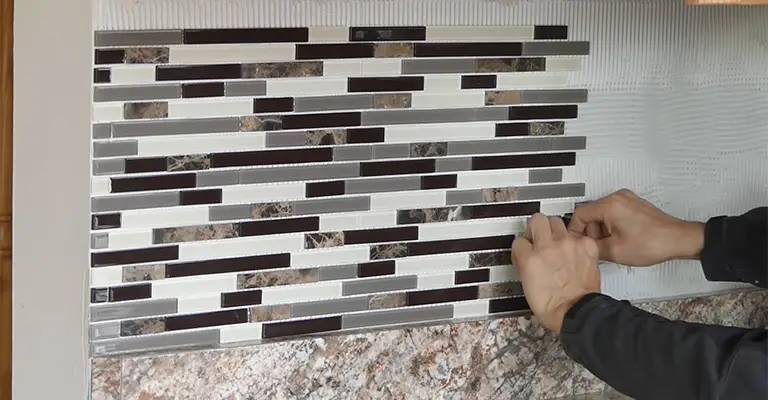
Tile can be laid over a plastic laminate backsplash with square edges rather than rounded or molded edges. The steps are as follows:
- Remove any grease or dirt from the backsplash by cleaning and drying it.
- You will need to sand the laminate (50-80 grit) to enable the adhesive to adhere. Sanding the countertop and wall with an orbital sander works great, but take care not to damage them.
- To remove dust, wipe the backsplash down with a damp cloth.
- Painter’s tape will prevent the tile adhesive from adhering to the countertop if you cover it with Kraft paper or plastic sheeting.
- Tile the backsplash after applying thin-set adhesive with a notched trowel.
- The tile adhesive should be allowed to cure overnight.
- Allow to dry after applying grout and wiping away excess.
I wish you all the best with your project.
Why Tile Over Laminate Backsplash?
It is usually necessary to replace laminate counters that are severely aging. Laminate counters do not develop an attractive patina like marble, soapstone, granite, wood, or even solid surface counters.
Eventually, laminates become scratched and chipped, revealing the lower image layer and finally the core layer beneath the top wear layer.
However, you can replace the laminate countertop with tile rather than replace the entire countertop.
You can do this fairly easily, and it’s also a lot of fun and creative. A laminate countertop can be revitalized for little more than the cost of tile and accessories.
Basics of Tiling a Countertop Over Laminate
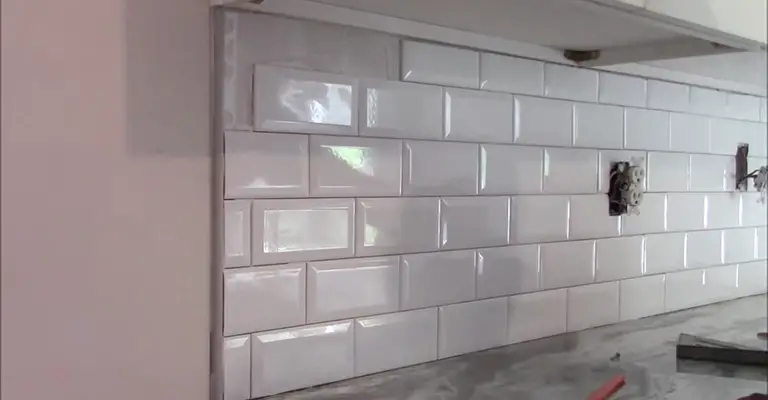
It is possible to apply ceramic or porcelain tile directly on top of laminate if the laminate surface and its lower substrate are in good condition. The flat, smooth, level surface of a laminate countertop is nearly perfect for tiling.
For tiling over laminate, four-inch square tiles are commonly used. Due to its size, it does not create as many seams as 1-inch mosaic tiles.
However, because of its small size, it is easier to cut and fit, and more visually appealing than 12-inch or 16-inch tiles.
A countertop of average size takes six to eight hours to install. It may take several days to complete the grouting because it needs time to cure. Ensure that the mortar you use adheres properly to the substrate by selecting the right mortar.
Pros
- Easy-to-work-with materials
- Environmentally friendly
- Styles to suit all tastes
- Cost-effective
- A fast turnaround time
Cons
- Resale value may be lower
- Counters must be structurally sound
- Laminates with square edges only
- Grout seams
How to Tile a Countertop Over Laminate?
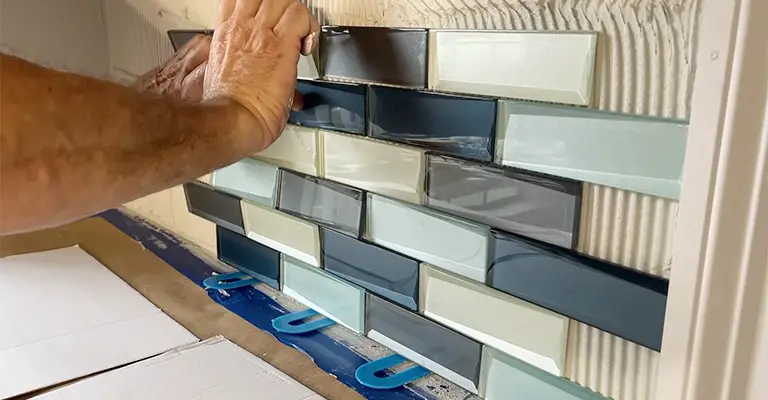
As compared to square edge laminate, wrapped edge laminate is more attractive and more resistant to chipping.
Wrapped edge laminate countertops can’t be tiled over because of their rounded profile. Tile can only be installed on countertops with squared-off, 90-degree angle edges.
Things You Will Need:
- Trowel: 3/16-inch to 5/32-inch V-notch
- Rubber tile float
- Orbiting oscillating electric sander and sanding discs
- Tile spacers
- Tile nipper
- Tack cloth
- Wet tile saw or rail tile cutter
- Tile grout
- Trisodium phosphate (TSP)
- 4-inch square ceramic tile
- Bullnose or other profile 2-inch ceramic tile trim
- Ceramic tile adhesive such as thinset
Assess the Base for Structural Support

Particleboard (medium-density fiberboard or MDF) usually serves as the base for laminate. Depending on how well the laminate countertop has been maintained, the particleboard may still be suitable for tiling.
Water contacting the particleboard will cause it to sag, break, or flake away. Take a look underneath: around the sink and particularly toward the back.
Stains caused by water are common, but they do not always indicate structural failure. Check the stability of the board with a screwdriver.
Fix Peeling Laminate
Be careful not to let the laminate peel away from the particleboard at the top. The tile will eventually lift up if the countertop is delaminating.
Reapply the laminate using contact cement. Make a riser out of wood to separate the laminate from the base. Apply contact cement to each surface and let it dry until it tacks. After that, press the laminate into the base.
Remove or Cover Obstructions
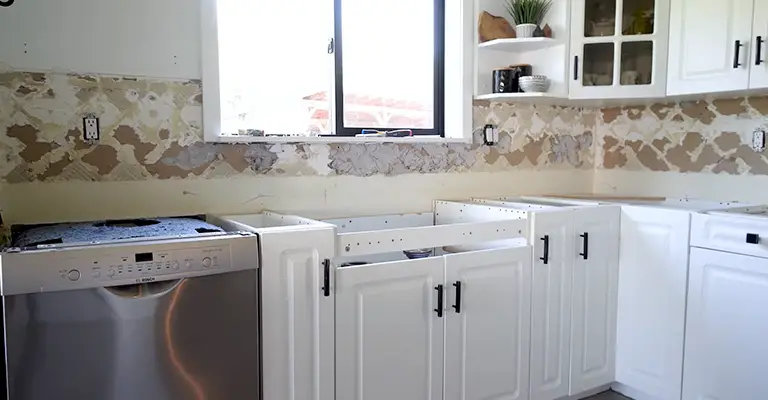
All items that cover the laminate countertop and sides must be removed or covered, including sinks, faucets, cooktops, and everything else. If possible, it is always best to remove items.
Roughen the Laminate Surface
A single pass with 60 grit paper on an orbital oscillating electric sander will provide a smooth finish to the laminate surface.
Rather than sanding deeply, we aim to leave a field of fine scratches all over the surface. Sand the edges without chipping them.
Clean the Laminate
TSP is recommended over household cleaning products that may leave residue on laminate. To remove the remaining dust, use a tack cloth.
Dry-Fit the Tile on the Countertop
There is a possibility that a four-inch-square ceramic tile won’t fit perfectly into a countertop depth. Uncut tiles should be placed in front, while cut tiles should be placed in the back.
You should position the ragged cut side of a rail tile cutter against the wall for later covering with a backsplash.
Cut The Tiles
All tile-cutting should be done before mixing mortar. The tile-cutting should be completed before the more time-sensitive step of working with mortar. A wet tile saw or a rail-type cutter can be used to cut the tiles to size.
Spread The Mortar And Lay The Tiles
Use the V-notch trowel to trowel out the mortar in manageable 2-foot square sections. Tiles should be flush with the edge of the countertop on the front and sides. Maintain proper seam width by using plastic spacers.
Tip
A quarter-inch to three-eighth-inch of tile space should be left around the sink cutout. The tile may prevent the sink from being reinstalled if it is too close to the sink. The sink lip may not cover the tiles if the tile is too far away.
Let the Tile Cure
It usually takes 24 to 72 hours for ceramic tile adhesives to cure completely. Consult the adhesive’s instructions. When grouting the tiles, it is important to let them cure fully.
Grout the Tile
Tiles should be grouted diagonally with the rubber float, and grout should be fully pressed into the seams.
Options
Add a Backsplash
It will be necessary to cover the backside of the tile, closest to the wall, with a backsplash later on.
You can use the same tiles as the countertop or marble, copper, or peel-and-stick materials for the backsplash.
Cover the Laminate
Backer board can be used to cover laminate that is peeling too much and cannot be repaired. The laminate can be directly backed with cement.
Seams should be taped up with fiberglass mesh tape. In addition to providing a fail-proof surface for installing tiles, it eliminates the need to sand.
Can You Put Granite Tile Over the Laminate Backsplash?
Granite tiles can be used as a covering for laminate backsplashes if they are properly prepared. Before you begin, make sure the laminate is clean and free of grease and oil.
In addition to roughening up the area with sandpaper, you should also use tile adhesive. Using a notched trowel is the best way to apply a tile adhesive designed specifically for granite.
You can now begin setting the tiles once the adhesive is in place. If necessary, cut tiles with a wet saw using spacers between each tile to ensure even spacing.
After the adhesive cures, grout the tiles after 24 hours. Using a rubber float, apply a grout that matches the color of the tile.
Allow the backsplash to cure for at least 48 hours after removing any excess grout with a damp sponge.
Can You Put Peel and Stick Tile Over Laminate Backsplash?
As long as the laminate backsplash is clean, smooth, and dry, peel-and-stick tiles can be applied. As well as checking the laminate for cracks or holes, it’s important to ensure that it’s in good condition.
A self-leveling compound should be used before installing the tile if the surface isn’t completely level. Using peel-and-stick tile for a backsplash is a great option since it doesn’t require grouting and is easy to install.
In addition, it’s easy to maintain and clean. It is important to keep in mind that peel-and-stick tiles are not heat-resistant, so they are not recommended for use behind stoves. Consider using glass tile for a heat-resistant backsplash.
Final Words
You don’t need to tear out the existing decoration to update the backsplash in your kitchen. Simply follow these simple steps.
In addition to its ease of use, it can be used to create a variety of looks, such as classic subway tiles and more modern geometric shapes.
You can also protect your walls from water damage and makeup stains by tiling over laminate.
You can be proud of your new backsplash if you take your time, use the right tools and materials, and follow the instructions carefully.

